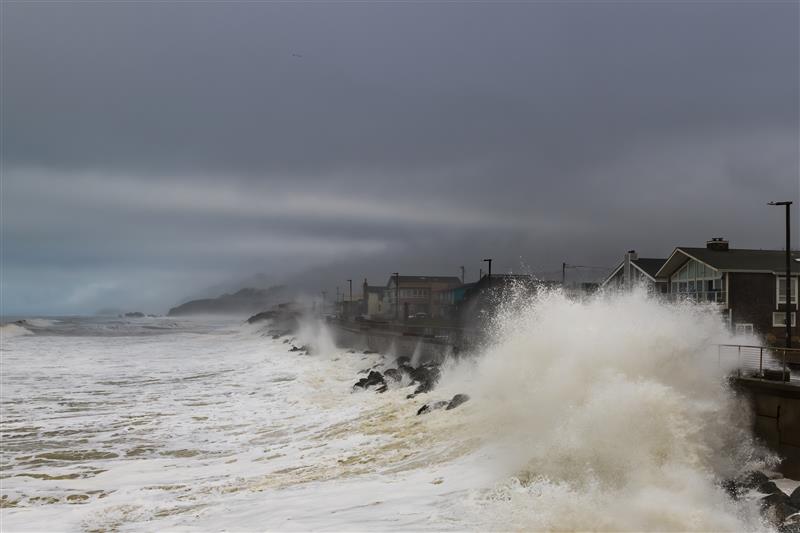State of California Sea Level Rise Guidance: 2024 Science and Policy Update – Draft Released for Public Comment – Deadline Extended to March 8
The State of California Sea Level Rise Guidance: 2024 Science and Policy Update was adopted at the June 2024 Council Meeting.
OPC is pleased to release the draft State of California Sea Level Rise Guidance: 2024 Science and Policy Update (Guidance), which will update and replace the previous 2018 State of California Sea-Level Rise Guidance. This report consists of the best available science on sea level rise and coastal impacts with pragmatic and practical approaches for using this new scientific information in planning and decision-making.
Sea level rise and increased climate-driven flooding will continue to threaten public health and safety, critical infrastructure, coastal habitats, private property, and public access in California. To build resilience for coastal communities and ecosystems, thoughtful science-based planning and adaptation actions need to happen now. This Guidance, coupled with the recently launched Senate Bill 1 Sea Level Rise Adaptation Grant Program and $660 million maintained in the Governor’s FY 24/25 Budget for critical coastal resilience programs and projects, will help prepare California for sea level rise.
Released for public review and comment, this Guidance is updated approximately every five years and includes updated projected sea level rise through 2150 and guidance to help state, tribal, local, and regional jurisdictions integrate this science into coastal adaptation projects, resilience planning, and investments.

Key takeaways from the updated science include:
- There is greater certainty and a narrowing range of the amount of sea level rise through 2050, with a statewide average of 0.8 ft of rise projected in the next 30 years.
- By 2100, statewide sea levels are expected to rise between 1.6 ft and 3.1 ft (Intermediate-Low to Intermediate Scenarios), and even higher amounts cannot be ruled out.
- Beyond 2100, the range of sea level rise becomes increasingly large due to uncertainties associated with physical processes, such as earlier-than-expected ice sheet loss and resulting future sea-level rise. By 2150, statewide sea levels may rise from 2.6 ft to 11.9 ft (Intermediate-Low to High Scenarios), although even higher amounts are possible.
- The extreme sea level rise scenario (i.e., H++) from Rising Seas 2017 is much higher than the best available science suggests and is not included in the 2024 update.
- Vertical land motion (uplift or subsidence) is the primary driver of local variations in sea level rise across the state. Vertical land motion is incorporated into the sea level scenarios for the 13 tide gauges along the coast and in San Francisco Bay, providing more locally specific information.
- Sea level rise, when combined with extreme storms and higher tides, will result in accelerated cliff and bluff erosion, coastal flooding and beach loss, and mobilization of subsurface contaminants.
The draft Guidance recommends a precautionary stepwise process for incorporating sea level rise scenarios into planning and projects that includes adaptation pathways to phase actions over time.
For most planning and projects, the Guidance recommends evaluating Intermediate, Intermediate-High, and High scenarios to assess a spectrum of potential impacts. Analysis of storm conditions is also recommended, as appropriate, to incorporate other drivers of coastal flooding. Selecting a sea level rise value for project or planning application will depend on local factors, but an approach that considers risk aversion is recommended.
The draft Guidance was developed by OPC, in partnership with the California Ocean Science Trust and a scientific task force. It was also informed by member agencies from the State Sea Level Rise Collaborative, including but not limited to, the Coastal Commission, State Land Commission, San Francisco Bay Conservation and Development Commission, Caltrans, State Parks, and the Department of Water Resources. It was also informed by early consultation with California Native American tribes, through listening sessions and formal government-to-government consultation.
Questions?
For more information, please contact Justine Kimball, Senior Climate Change Program Manager at justine.kimball@resources.ca.gov.
Public Comment
OPC has extended the deadline for public comment on the draft State of California Sea Level Rise Guidance: 2024 Science and Policy Update (Guidance) to Friday, March 8, 2024, from the previous deadline of Monday, March 4, 2024.
Please email all public comments directly to OPC Sea Grant Fellow, Ben Dorfman, at ben.dorfman@resources.ca.gov with the subject line “Sea Level Rise Guidance – Public Comment”.
OPC held a public webinar on Monday, February 5. (View the webinar recording) Additionally, four virtual regional workshops were held:
- Central Coast: February 13, 2024
- North Coast: February 14, 2024
- South Coast: February 15, 2024
- San Francisco Bay Area: February 16, 2024
These virtual regional workshops provided opportunities to discuss how the draft Guidance can be applied in regional contexts. In facilitated breakout sessions, participants had the opportunity to share a project or planning experience that they expect to be influenced by the updated Guidance. By walking through real-world applications, participants discussed where the Guidance requires further clarification, specificity, or editing. These workshops aimed to ground truth the Guidance with regional sea level rise planning efforts.
Please check back to this page and subscribe to our email newsletter for updated information.
The final Guidance will be presented to the Ocean Protection Council for review and adoption at its June 4, 2024 meeting.

